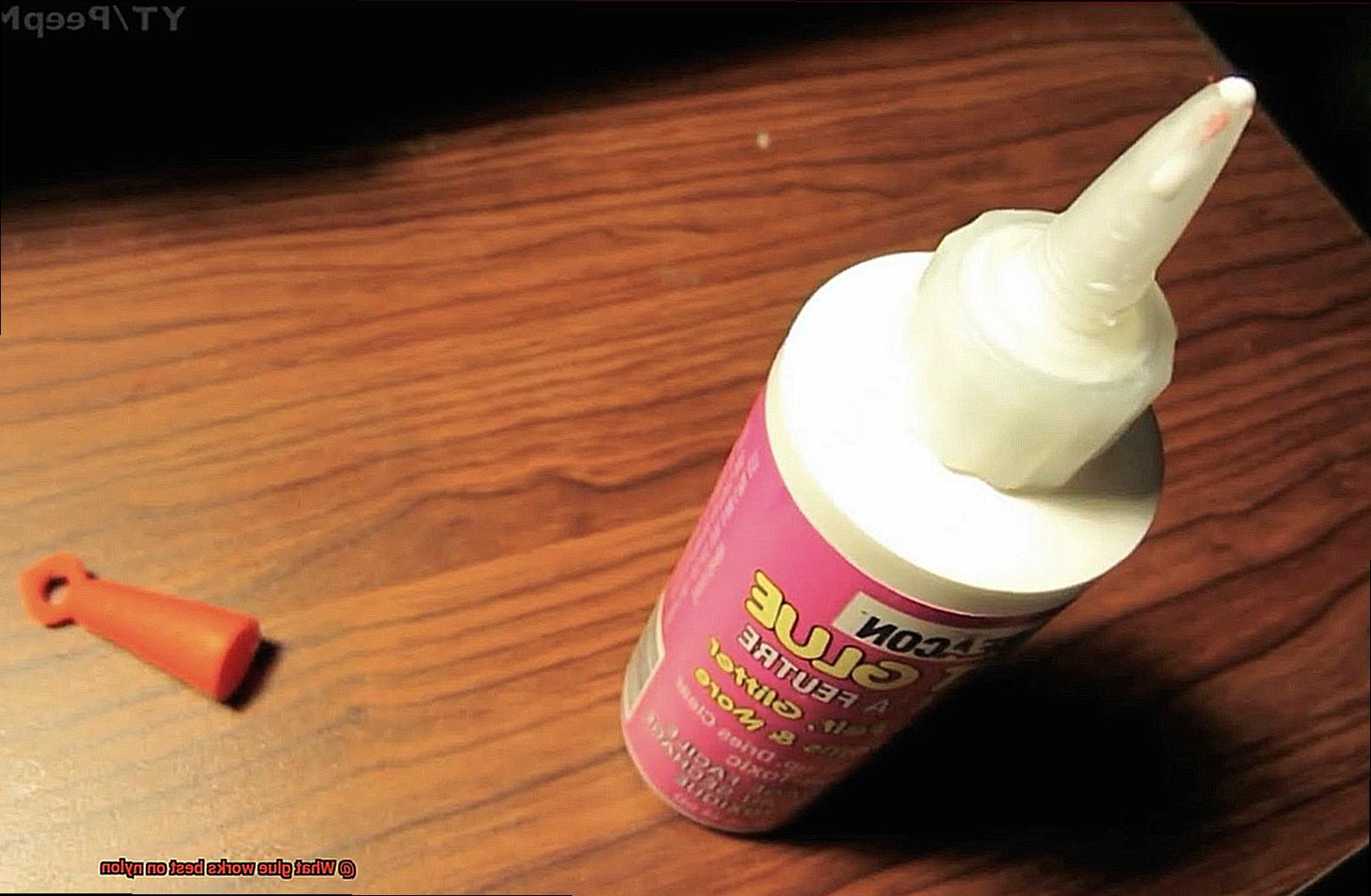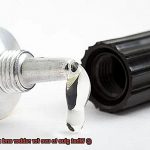Got a nylon emergency? Don’t worry, we’ve got you covered. Finding the right glue for nylon can be as tough as untangling headphone wires. But fear not, because in this blog post, we’re diving deep into the world of adhesives to help you find the perfect match for your nylon repair or DIY project.
Nylon is like the superhero of fabrics – strong, durable, and ready to take on any challenge. Whether you need to fix a ripped backpack or attach patches to your favorite nylon jacket, having a trusty glue by your side is an absolute must.
So let’s get down to business and explore the top contenders for gluing nylon. We’ll spill all the secrets about their strengths, weaknesses, and even throw in some insider tips to ensure your project turns out picture-perfect.
What glue works best on nylon?
Contents
Epoxy Glue:
Prepare to be amazed by epoxy glue. This adhesive is like a ninja warrior when it comes to bonding nylon. It’s tough, water-resistant, heat-proof, and chemical-proof – basically indestructible. But beware, working with epoxy can be a bit tricky since it requires careful mixing and patience while it dries.
Cyanoacrylate (Super Glue):
Need a quick fix? Super glue to the rescue. Known for its lightning-fast bonding powers, cyanoacrylate glue is perfect for those urgent repairs. It forms an unbreakable bond in seconds that can withstand almost anything…well, except extreme bending or stress. So it might not be ideal for high-flex areas.
Multipurpose Adhesive:
When it comes to versatility, multipurpose adhesives are your best buddies. Urethane-based or polyurethane glues are great options for all sorts of nylon projects. They offer flexibility and stand up against water and heat like champs. Just keep in mind that these glues might require clamping during drying and can sometimes leave a visible residue – but hey, it’s what’s on the inside that counts.
Before you dive into the glue game, don’t forget to give your nylon surface a good scrub to remove any dirt or oils. And always, always test your chosen adhesive on a small, hidden area before going all-in. Better safe than sorry, right?
With the right glue and a sprinkle of know-how, you’ll be tackling those nylon projects like a pro in no time. Stay tuned
What is Nylon?
When it comes to materials that exhibit exceptional strength, durability, and versatility, nylon sits at the top of the list. Developed in the 1930s by chemist Wallace Carothers at DuPont, nylon has become a popular synthetic polymer used in various industries. In this blog post, we will dive into the world of nylon, exploring its properties and applications.
Exploring the Properties of Nylon:
Nylon is a type of polyamide that boasts incredible mechanical properties. It is created through polymerization, where monomers are linked together to form long chains. This process results in a material that is not only robust but also resistant to wear and tear.
Strength and Durability:
One of the key characteristics of nylon is its high tensile strength, allowing it to withstand significant force before breaking or deforming. This property makes it ideal for applications such as ropes, cables, and fabrics used in outdoor gear and sports equipment.
Resistance to Environmental Factors:
Nylon exhibits excellent resistance to abrasion, chemicals, and heat. It can maintain its integrity even in harsh environments, making it suitable for automotive parts, electrical insulators, and industrial components.
Low Coefficient of Friction:
Nylon’s smooth texture and low coefficient of friction make it perfect for reducing friction and wear in moving parts such as bearings and gears. This property ensures smooth operation and longevity.
Versatility in Processing and Modification:
Nylon’s versatility extends beyond its mechanical properties. It can be easily molded into different shapes using techniques like injection molding or extrusion. Furthermore, nylon can be blended with other materials to enhance specific properties or characteristics.
Types of Nylon:
Nylon is available in various grades and forms to suit different applications. Nylon 6/6 (PA66) offers a balance of strength, toughness, and chemical resistance. Other variations include nylon 6 (PA6) and nylon 12 (PA12), each with unique properties.
Types of Glue for Bonding Nylon
Selecting the right glue for bonding nylon is crucial to ensure a strong and long-lasting bond. Whether you’re working on a craft project or repairing a broken nylon strap, the perfect adhesive is essential. In this article, we will explore the various types of glue suitable for bonding nylon, discussing their unique advantages and considerations.
Epoxy Glue – Unmatched Strength and Durability:
Epoxy glue is a popular choice for bonding nylon due to its exceptional strength and durability. Formulated with a resin and hardener, it creates a powerful adhesive when mixed together. This type of glue is perfect for applications that require the bond to withstand heavy loads or stress. However, it’s important to note that epoxy glue can be messy to work with and requires careful mixing and application.
Cyanoacrylate Glue – Quick and Convenient:
Cyanoacrylate glue, also known as super glue or instant glue, is ideal for quick fixes and small projects. It forms a strong bond rapidly and works well on smooth nylon surfaces. Super glue also provides good resistance to moisture and temperature changes. However, it may not be as effective on porous or textured nylon surfaces.
Polyurethane Glue – Flexibility and Water Resistance:
Polyurethane glue is a versatile adhesive that cures by reacting with moisture in the air or on the surface of the materials being bonded. It offers excellent flexibility and water resistance, making it suitable for applications where some movement or exposure to moisture is expected. However, it may take longer to cure compared to other types of glue.
Specialty Adhesives – Optimal Bonding Strength:
For optimum bonding strength on nylon surfaces, specialty adhesives designed specifically for this material are available. These adhesives often come in two-part systems or require specific surface preparation before application. They offer superior bond strength and durability compared to general-purpose glues. However, they may be more difficult to find and slightly more expensive.
Cyanoacrylate Adhesive (Super Glue)

Prepare to be amazed by the incredible bonding capabilities of cyanoacrylate adhesive, also known as super glue. This fast-drying and ultra-strong adhesive is a game-changer when it comes to bonding nylon materials. In this article, we will dive deep into the world of super glue, exploring its proper application techniques and highlighting its versatility in various DIY projects and repairs.
Preparation:
Before embarking on your bonding journey, it’s crucial to prepare the nylon surface properly. Wipe away any dirt, oil, or moisture that might hinder the adhesive’s effectiveness. A simple swipe with a clean cloth or a gentle wash with a mild detergent will do the trick.
Application:
When it comes to using super glue on nylon, remember that less is more. A small amount of glue directly applied to the nylon material is usually sufficient for a strong bond. Avoid going overboard with excessive amounts of glue, as it can lead to messy and uneven results. Apply the glue sparingly and precisely for optimal bonding.
Bonding Process:
Once you’ve delicately applied the super glue, press the bonded pieces together firmly for a few seconds. This allows the adhesive to set and work its magic. As time passes, your bond will continue to strengthen, reaching its maximum strength within 24 hours.
Super Glue’s Strength and Versatility:
Prepare to be astonished by super glue’s exceptional bonding power. It forms durable bonds that can withstand tension, shear, and impact forces with ease. Not only does it adhere perfectly to nylon, but it also works wonders on plastic, metal, ceramic, and wood. The adaptability of super glue makes it an invaluable tool for a wide range of DIY projects and repairs.
Flexibility Considerations:
While super glue is highly effective for bonding nylon, it’s important to note that it may not provide the same level of flexibility as other adhesives. Keep this in mind when working with certain nylon materials that require flexibility for their intended purpose.
Proper Storage:
To ensure the longevity of your super glue, treat it with care. Store it in a cool and dry place, away from direct sunlight and excessive heat. By doing so, you’ll prevent the adhesive from drying out or losing its effectiveness over time.
Accidental Skin Contact:
In the unfortunate event of accidental skin contact with super glue, there’s no need to panic. Simply wash the affected area with warm soapy water and gently peel or roll the bonded skin apart. Avoid using force or pulling forcefully, as this can cause injury. If any irritation or discomfort persists, seek medical attention promptly.
Epoxy Adhesives
If you’ve been on the hunt for a glue that effectively sticks to nylon, look no further. Epoxy adhesives are here to save the day.
Advantage 1: Unparalleled Versatility
Epoxy adhesives are renowned for their remarkable versatility in bonding different materials, and nylon is no exception. From nylon fabrics to ropes and plastic parts, epoxy adhesives have got your back. Their unique composition of resin and hardener ensures a bond that can withstand various applications and environments.
Advantage 2: Defying Adhesion Challenges
Bonding nylon materials can be quite a challenge due to their smooth surface and low porosity. However, epoxy adhesives rise to the occasion by providing exceptional adhesion to nylon surfaces. How do they do it? The resin component of the adhesive penetrates the nylon surface, creating mechanical interlocking and increasing the bond strength. Additionally, the chemical reaction between the resin and hardener forms strong chemical bonds with the nylon molecules, enhancing the adhesive strength even further.
Advantage 3: Strength that Endures
Nylon is known for its high strength, durability, and resistance to wear and tear. It only makes sense to choose an adhesive that matches these qualities. Epoxy adhesives deliver on this front by forming a bond that can withstand significant stress, ensuring your nylon creations remain intact for extended periods. Whether it’s a backpack strap or a DIY repair project, epoxy adhesives provide the durability you need.
Application Tips:
To achieve optimal bonding results with epoxy adhesives and nylon materials, it’s vital to follow a few key steps. First, prepare the nylon surface by ensuring it is clean, dry, and free from any contaminants or oils. Wiping it down with isopropyl alcohol or a suitable cleaning agent will do the trick.
Next, follow the manufacturer’s instructions for mixing the resin and hardener components. Apply the mixed adhesive evenly onto one of the surfaces to be bonded, ensuring complete coverage. Then, firmly press the surfaces together, holding them in place until the adhesive cures.
Polyurethane Adhesives
Polyurethane adhesives are the superheroes of the adhesive world, especially when it comes to bonding nylon materials. These exceptional glues are the go-to choice for industries such as automotive, construction, and manufacturing. So what exactly makes polyurethane adhesives the ultimate glue for any project involving nylon? Let’s explore their advantages in detail.
Firstly, polyurethane adhesives possess a strong bonding capability that sets them apart from other adhesives. They have the unique ability to effectively penetrate the smooth and non-porous surface of nylon, creating a robust and secure connection. No matter the stress or strain your nylon materials face, you can trust that they will stay firmly in place.
Polyurethane adhesives also excel in resisting environmental factors that would normally weaken a bond. Moisture, chemicals, temperature fluctuations, and even UV radiation are no match for these incredible glues. Whether your project is indoors or outdoors, polyurethane adhesives will withstand the elements and maintain their strength over time.
Flexibility is another key advantage of polyurethane adhesives when bonding nylon materials. Nylon can expand or contract due to temperature changes or stress, but polyurethane adhesives have the unique ability to flex and accommodate these movements without compromising the bond. This flexibility ensures that your adhesive remains intact even under dynamic conditions, giving you peace of mind knowing your nylon materials are secure.
Last but not least, polyurethane adhesives offer excellent impact resistance. When faced with mechanical stress or vibrations, which are common challenges for nylon components, these glues will keep your bond strong. Say goodbye to premature failure or damage and hello to a lasting and reliable bond.
Glues to Avoid on Nylon
When it comes to working with nylon fabric, choosing the right glue is crucial for a successful and durable bond. Not all glues are suitable for nylon, as some can weaken the fabric or even cause damage. Here are some glues to avoid when working with nylon:
- Super Glue: Despite its reputation for creating strong bonds, super glue is not the best choice for nylon. Its strong adhesive properties can actually make nylon fabric brittle and more prone to tearing. Save your super glue for other materials.
- Epoxy: While epoxy adhesives are known for their versatility, they may not provide a secure bond on nylon. Additionally, epoxy can leave visible residue on the fabric, ruining the look of your project.
- Solvent-Based Glues: These glues contain harsh chemicals that can weaken or discolor nylon fabric. It’s best to avoid them altogether to prevent any damage.
- Hot Glue Guns: Hot glue guns are fantastic for many crafts, but they’re not the right choice for nylon. The high temperatures of hot glue can melt or warp the nylon fibers, resulting in a weak and unreliable bond.
Now that we know which glues to avoid, let’s explore two great options for bonding nylon:
- Specialized Fabric Glues: Look for glue specifically designed for nylon fabrics. These glues are formulated to provide a strong bond without damaging the fabric. They are ideal for various applications such as repairing clothing or upholstery made of nylon.
- Two-Part Polyurethane Adhesives: These adhesive superheroes are perfect for nylon fabrics. They offer excellent adhesion and flexibility, creating a bond that can withstand stress and strain without breaking. Two-part polyurethane adhesives provide a reliable and long-lasting bond on nylon.
Remember, preparation is key when working with nylon and adhesive. Clean the fabric surface to remove any dirt or oils that could interfere with the bonding process. Always read and follow the manufacturer’s instructions for the best results.
Preparing the Nylon Surface
Well, buckle up because preparation is the secret ingredient to a successful bond. Just like a superhero needs a trusty sidekick, your glue needs a well-prepared nylon surface to create a strong and durable connection. So, let’s gear up and dive into the process of preparing the nylon surface.
First and foremost, cleanliness is key. Before applying any glue, ensure that the nylon surface is free from dirt, dust, or oils. Grab a clean cloth or rag and gently wipe away any loose debris. Treat those delicate nylon fibers with care.
For stubborn stains or dirt, it’s time to bring out the heavy artillery – a mild detergent mixed with water. Apply this solution to a soft cloth and give the affected area a gentle scrub. Rinse with clean water and allow it to dry completely before moving forward.
But what if there are oily residues lingering on the nylon surface? Fear not. You’ll need something a little stronger. Look for a solvent-based cleaner specifically designed for nylon. Apply a small amount onto a clean cloth and gently rub it onto the surface. Remember, safety first. Follow the manufacturer’s instructions for usage.
Now that our surface is clean and dry, let’s roughen it up slightly to enhance adhesion. Find some fine-grit sandpaper and give the area a gentle sanding. This will create more texture for the glue to grip onto, ensuring a stronger bond.
Almost there. After sanding, make sure to remove any residue by wiping the surface with a clean cloth or blowing away the particles with compressed air. We don’t want anything interfering with our bonding process.
But wait, there’s more. Temperature and humidity also play a role in gluing success. For optimal results, work in moderate temperatures and low humidity levels. Extreme heat or cold, as well as high humidity, can affect the drying and curing process of the glue.
Last but not least, a wise glue enthusiast always tests before committing. Before embarking on your grand gluing adventure, apply a small amount of glue to a small inconspicuous area of the nylon surface. This will ensure compatibility and provide peace of mind when it comes to adhesion and strength.
Mechanical Fasteners vs Glue for Bonding Nylon
When it comes to bonding nylon, the age-old battle between mechanical fasteners and glue rages on. Let’s dive into these two contenders and see which one takes the crown.
In the left corner, we have mechanical fasteners – the nuts, bolts, screws, and rivets that have been around since the dawn of time. These trusty companions are known for their strength and reliability. They can withstand high levels of stress and tension, making them perfect for applications that require durability. Plus, they offer the added advantage of easy disassembly and reassembly when maintenance or repairs are needed.
But beware. Installing mechanical fasteners can be a bit of a chore. It takes time and may require additional tools and equipment. And let’s not forget about the holes they leave behind in the nylon material. These holes can weaken its structural integrity and potentially lead to failure. So while mechanical fasteners are dependable, they may not always be the most convenient option.
In the right corner, we have glue – the superhero sidekick of bonding nylon. Glue offers convenience and efficiency that can save you time and effort. There are various types of glues available specifically designed for bonding nylon materials.
One popular choice is cyanoacrylate adhesive, also known as super glue. This adhesive forms a strong bond quickly and effectively. It’s easy to use, dries clear, and has good resistance to moisture and temperature changes. Another option is epoxy adhesive, which provides a durable and long-lasting bond that can withstand heavy loads or vibrations.
But hold your horses. Before you start gluing everything together, there are a few things to keep in mind. Proper surface preparation is crucial when using glue. You’ll want to clean the nylon surfaces thoroughly to remove any dirt, grease, or contaminants that could interfere with the bonding process. A solvent-based cleaner designed for nylon works wonders for this task. And don’t forget to roughen up the surface slightly with some fine-grit sandpaper to enhance adhesion.
Temperature and humidity also play a role in the glue’s performance. Working in moderate temperatures and low humidity levels ensures optimal drying and curing. Extreme heat, cold, or high humidity can mess with the process and compromise the bond.
So, which one is the winner? Well, it depends on your specific application needs. If you’re looking for strength, durability, and the ability to disassemble and reassemble, mechanical fasteners might be your best bet. But if convenience and efficiency are at the top of your priority list, glue is the way to go.
mORL1jJSdlk” >
Also Read: Does Gorilla Glue Work On Fabric?
Conclusion
When it comes to finding the perfect adhesive for nylon, you want something that sticks like a champ.
After all, nylon is a tough and resilient material that requires a glue with serious staying power. So, what glue works best on nylon?
Well, let me tell you, my friend, there’s one adhesive that reigns supreme in the world of nylon bonding: epoxy. Yes, epoxy is the go-to glue for all your nylon needs.
Its strong and durable formula ensures a bond that can withstand even the toughest of challenges. Whether you’re repairing a torn nylon backpack strap or creating a DIY project out of this versatile material, epoxy will be your trusty sidekick.
So next time you find yourself in need of some serious bonding power for your nylon projects, remember one word: epoxy.






